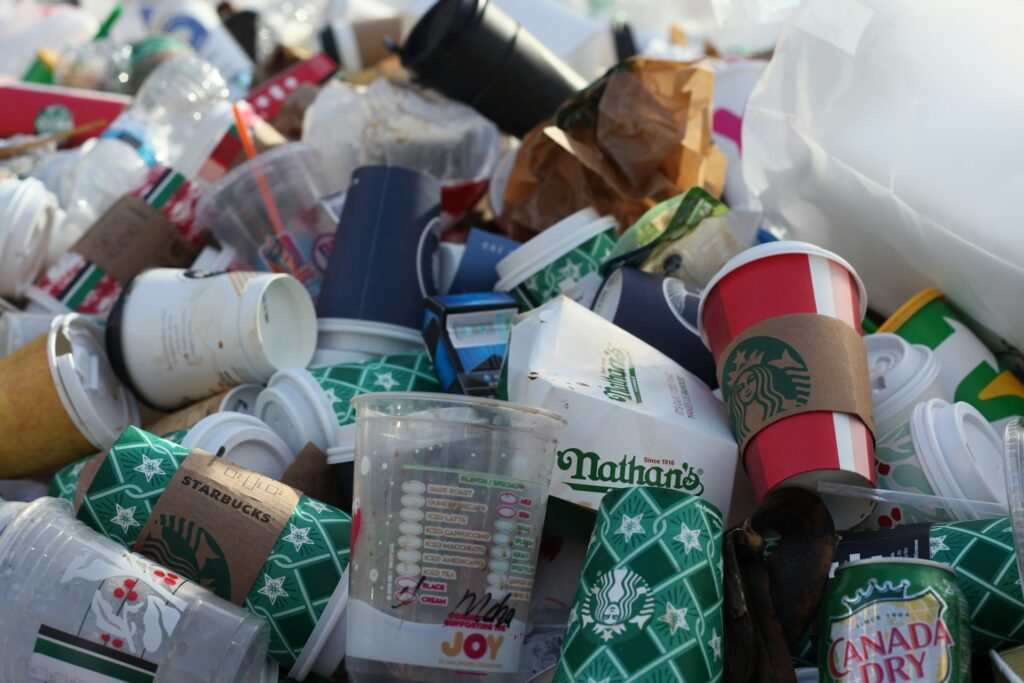News Team member Merom Arthur describes what is known about the relationship between climate change and extreme weather and how we can prepare for these events.
Keeping Food Waste out of Landfills is a Critical Environmental Goal — and Restaurants Can Help
The volume of compostable waste that restaurants generate far outweighs what households do, and keeping it out of landfills is critical
By Gillian Feinglass
In a hot New York City summer, I stood knee-deep in a sea of food scraps and compostable plates and forks with the city’s skyline behind me. I was an intern for Earth Matter NY, a nonprofit dedicated to reducing food waste in NYC; the trash I stood in was from Governors Island, a park in New York harbor that Earth Matters ensures is is zero-waste. I felt inspired, knowing the mountains of waste would soon be transformed into nutrient-rich compost, a resource of immense environmental benefit. And yet, I felt disheartened knowing that most of NYC’s food waste would not go through this process. Instead, it would be tossed in landfills, forgotten about forever, squandering precious resources on a massive scale and causing substantial environmental harm. This is what happens to food waste across the United States, which is the world’s third-largest generator of food waste. But it doesn’t have to be this way.
The city government is aware of the magnitude of food waste going into landfills and has taken steps to address it. The government created the largest curbside organics collection program nationwide, and hundreds of Smart Composting Bins line the bustling streets for on-the-go composting. A mandate passed by City Hall in the summer of 2023 requires all NYC residents to compost beginning in 2025. This will keep an estimated 160 garbage trucks full of food waste — the equivalent of 8 million pounds — out of landfills.
These are commendable and necessary steps to mitigate individuals’ food waste. After all, households produce nearly half of America’s surplus food. Yet as vital as these residential initiatives are, they only scratch the surface of the food waste problem. To really make a difference, the city has to tackle a harder problem: waste from restaurants.

Restaurant waste is a stubborn problem
Even if all NYC households properly diverted their waste, which is far from current reality, the environmental impact would be inconsequential compared to the volume that restaurants continue to throw away. NYC’s 27,000 restaurants send more than 73 percent of their food waste to landfills, an amount too consequential to ignore. While individuals produce a variety of waste in the same trash bag — think orange peels and leftovers you knew you’d never eat, mixed with Ziploc bags and old shoelaces — most restaurant waste is only organic. (In this context, organic doesn’t indicate an agricultural production system; it means just that the waste originates from plants or animals, and excludes metals and other made materials.)
Earth Matter NY’s co-founder and executive director, Marisa DeDominicis, says, “NYC should target the commercial realm first because large amounts of food waste happen in restaurants, and educating employees on proper waste separation like we have on Governor’s Island is relatively straightforward.” There is a glaring absence of similar efforts to encourage restaurants to divert their waste from landfills despite the prime opportunity that diverting restaurants’ massive volume of food waste presents.
One of the worst things we can do to the environment is continue to throw away our food in landfills. Over a third of America’s food supply is wasted along with all the water, energy, fertilizer, fuel, pesticides, and labor invested in its production. The average American family of four discards a staggering 1,000 pounds of food waste annually. This quantity may be difficult to visualize, but its cost of roughly $1,500 is not. This problem is best understood through comparisons. American food waste consumes the water usage of 50 million U.S. homes and the energy needed to drive 83 million passenger vehicles. This wastefulness is not just an ecological disaster; it’s an economic one, costing the U.S. a shocking $408 billion annually.
Restaurants are significant contributors to this problem, discarding between four to ten percent of their food before it reaches consumers, while plate waste comprises a startling 70 percent of discarded food. As a result, restaurants can play a consequential role in reducing the amount of food waste destined for landfills.
Sustainability can be costly
But understanding the environmental harm caused by food waste in landfills isn’t enough to persuade restaurant owners to change their waste management practices. If the climate crisis has taught us anything, it’s that issues like this cannot be addressed by only appealing to the goodness of restaurant owners’ hearts and showing them distant images of dying polar bea/rs to drive the change so urgently required.
In an industry with an average profit margin of three to five percent, restaurant owners must aim first to keep their businesses thriving and profitable, as well as their customers’ bellies full. And many struggle to do just that. A survey I conducted of dozens of NYC restaurants revealed that over 90 percent of respondents are concerned about the costs associated with sustainable waste management practices, reflecting the common perception that pursuing sustainability initiatives is inherently unprofitable or unrealistic.

However, “sustainability” has often been misconstrued, associated with grand, expensive, and politically divisive initiatives. There is nothing political about reducing waste. Every business can and should embrace sustainable practices. Waste diversion shouldn’t be viewed as a burden but as a prudent financial decision, especially in the long run. Champions 12.3, a coalition focused on achieving Sustainable Development Goal (SDG) Target 12.3 to cut global food waste in half by 2030, conducted a report in 2019 across 12 countries. The review found that in the initial year of using a food waste reduction program, 76 percent of the 114 restaurants studied recovered their initial investment. Within two years, 89 percent had recouped their investment.
Measuring has proven to be a critical food waste reduction practice. Utilizing technology to track product quality and shelf life is an effective strategy to mitigate food waste generation. Collecting data on the extent and frequency of food wastage will reveal to restaurants how to make informed decisions that will cut costs, improve efficiency, and reduce waste.3
Restaurants lose $162 billion annually due to food waste. Dwelling on the potential financial impact of sustainability initiatives clouds the more exciting opportunity; restaurants’ are in a prime position to recoup costs previously lost to food waste. A 2020 study from the International Journal of Applied Management and Technology observed that for every $1 million spent on food purchases, approximately $100,000 is food waste.4 Prioritizing sustainable waste management practices can yield long-term cost savings for restaurants. In the Champion 12.3 report, restaurants saved seven dollars for every dollar invested in reducing food waste over three years.5 Over three years, restaurants saw a 58 percent reduction on average in food waste by weight, aligning with the target set by the United Nations SDG 12.3 to cut food waste in half.6 Money is an influential motivator. The added bonus, of course, is a more environmentally responsible and economically efficient industry.
Jacob Cohen, the owner of NYC restaurants Dell’anima and Libertine, acknowledges that food waste is “a huge area that can be improved” in restaurants. While his restaurants strive to mitigate as much waste as possible, there is always some, particularly consumer plate waste. Cohen adds, “Separating waste would not be a huge issue for us, as long as it’s easy and there are not a lot of steps or costs.” The problem for Cohen and other restaurant owners like him is twofold: not only do they lack resources to properly separate waste and the contacts for pickup, but enlisting a waste management company to transport it to a waste-to-resource facility creates added costs, which their competitors can avoid by continuing to dispose of their waste in landfills.
Governments must own the problem
The government is a powerful actor, perhaps the only one that can drive change at a necessary scale. Annette Nielsen, the executive director of The Hunter College NYC Food Policy Center, is “hopeful that NYC is ready to make strides in diverting food waste from landfills.” However, “what will be key is to make sure we have allocated the resources, staffing, and education to ensure that this is a success this round,” Nielsen adds. Given the economic and environmental consequences at stake, it is in the government’s best interest to invest in this challenge.
In addition, the government needs to proactively introduce programs that utilize tax incentives to encourage restaurants to voluntarily divert food waste. By facilitating partnerships with local waste management companies, the government would subsidize diversion costs while also planning for a future of systematic food waste reduction.
Finally, strategic investments in waste-to-resource infrastructure, such as anaerobic digestion, can transform organic waste into fuel for our cars and homes. Composting harnesses all the nutrients in our food waste to enhance soil quality and support plant growth – producing more nutritious and delicious produce. DeDominicis adds, “Composting is the number one way individuals can feel that they are making a change. They can see, literally before their eyes, the waste being diverted from landfills and transformed into productive soil.” Composting and anaerobic digestion are just some examples of how America’s food waste can contribute to a more robust economy and sustainable future.
In an ideal world, we could magically eradicate food waste. Greenhouse gases released from rotting food in landfills would cease. Tremendous amounts of water, seeds, financial capital, and labor would no longer be recklessly squandered. But this is impossible. While some food waste is inevitable, throwing it away in landfills is not. This calls for action on multiple fronts: striving to waste as little as possible, diverting our own waste from landfills, inspiring businesses to follow suit, and compelling our governments to take decisive measures and invest in a future of waste management where no food waste is wasted. It’s time we unite so that what we discard today becomes the cornerstone of a sustainable tomorrow.

